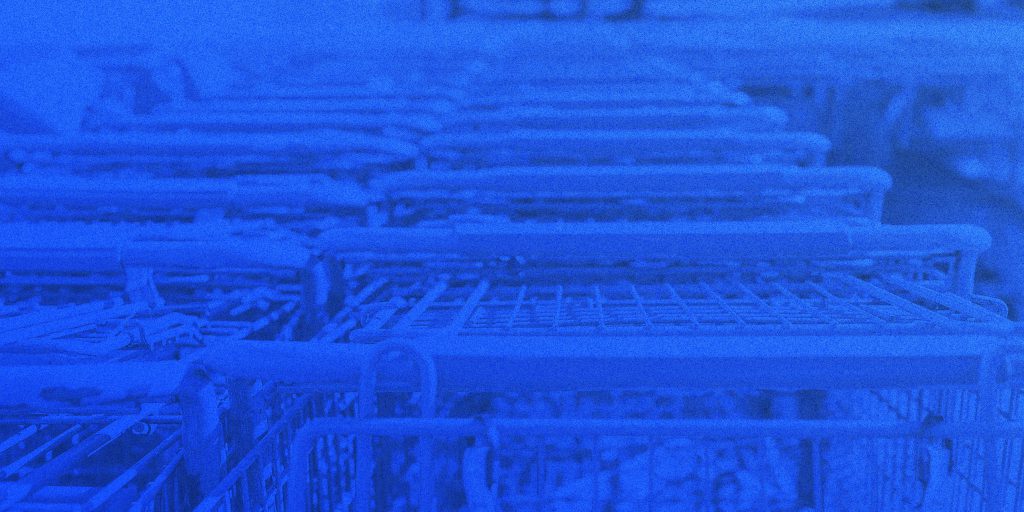In episode 6 of our Retail Oriented podcast we explore the implications of the pandemic-induced e-commerce shift and its impact on Amazon’s marketplace. Join us as we delve into the structure of Amazon’s business and make some predictions for the future of e-commerce.

Transcript
Emily Bratton:
How often did you not build shipping into the price of the good because you could charge the customer for it? And let’s be real, some manufacturers were making money on that shipping. Right?
Mike Fowler:
Yeah.
Emily Bratton:
Shipping and handling, let’s not all forget, but now they have to build it into the cost. They’ve had to change the way that they approach selling goods because of behaviors Amazon has taught all of us.
Mike Fowler:
Welcome back to Retail Oriented, retail fans. I am your host, Mike Fowler. I’m the VP of sales strategy here at Sales Factory, and I am really excited to have a very special guest, as you can see on her mug, Emily Bratton, our VP of digital, and also our resident e-commerce expert. Emily, thanks for joining us on the pod today.
Emily Bratton:
Thanks for having me.
Mike Fowler:
We’re going to talk about a lot of really interesting things today. The e-commerce world changed a couple of years ago in the wake of the pandemic, so we want to talk about what are the implications of that. We want to talk a lot about Amazon as a marketplace and how they’ve set up and structured their business. And then we may even get into some predictions for the future. So should be a good conversation, but I want to start with a little bit of your background. So Emily, just tell us how did you get to this seat today, tell us a little bit about your background specifically in regards to e-commerce.
Emily Bratton:
I started my career actually as a front-end web developer, which is not e-commerce, but quickly transitioned to do email marketing at Sierra Trading Post, which is owned by the TJX Companies, and there I learned a ton about how e-commerce works. They started as a catalog company, transitioned to online retail, and when I was working on their email marketing, they sold 70% of their revenue through emails alone. Crazy amount.
So that was an interesting first step. Came here to Sales Factory and then started to learn Amazon. So Jed is known for giving big tasks to hopefully smart people, and one of those was one our clients, they were having some challenges on Amazon and they decided, well, maybe Sales Factory can figure it out. And Jed said, “Well, maybe Emily can figure it out.” So I took over the Amazon account of one of our clients and they did quite a bit of sales on Amazon, so not low risk necessarily, and that’s how I started to learn about hands-on Amazon, how it works, advertising the issues, how not helpful their help desk is, all of those things. And here we are basically six years later and now run the digital and e-commerce team.
Mike Fowler:
And with everything digital and e-commerce, it is constant learning, right?
Emily Bratton:
Yes.
Mike Fowler:
So you’ve been learning since day one and are still learning today, right?
Emily Bratton:
Yes.
Mike Fowler:
So that’s just par for the course. Let’s level set for some of our listeners that may be really familiar with Amazon and marketplaces versus traditional e-commerce like a retailer that has brick and mortar and not, so can you start us with what are the basic e-commerce platforms that are out there? Obviously Amazon is one, but what are some of the others? And what are some of the little differences between them?
Emily Bratton:
That’s a very good question. So Amazon is definitely the leader in the retail space, and even Amazon has two different ways that you can interact with their marketplace. I would definitely say there’s a difference between a marketplace and just an e-commerce site. So if I’m doing direct to consumer, that’s just my brand, I’m selling it myself. That’s not a marketplace. A marketplace is where we have multiple sellers competing on price, shipping, all of those things. Amazon, the way that they work, they have 1P and 3P. So 1P is you’re treating Amazon more like a traditional retailer, you are selling them items and then they have control over those items, both from a warehouse perspective, from a price perspective, all of those things. Now, you can still promote your items just like you can in a brick and mortar store with shopper marketing.
Then we have 3P, so that’s third party sellers, and the concept there is that the third party seller is still controlling their goods. So they control price, they control their inventory, they have not sold it through Amazon, but they do pay Amazon a fee to be listed on their marketplace. So in most cases, it’s a 15% fee on the sale price of that item. Some of the other e-commerce leaders, Walmart doesn’t want to be left behind, so Walmart also is a marketplace. They have third party sellers just like Amazon does. And then as you start to go down the list of retailers, almost every other retailer has some sort of e-commerce platform, whether it’s a traditional marketplace or some kind of hybrid or something they control, that’s where it varies by these different retailers.
Mike Fowler:
So can we talk about assortment selection between Amazon and Walmart and some others, and somebody like Lowe’s or Home Depot or Target, for example?
Emily Bratton:
Yeah. Well, I think Amazon, obviously assortment, you can find anything on Amazon. That’s the cool thing about Amazon. And for sure Walmart.com very specifically is trying to copy that same kind of thing. But when I think about retailers and why I trust brick and mortar, it’s actually that they have filtered or somehow qualified the products that they put on the shelf. So there was this concept that the digital shelf was infinite, that a brick and mortar shelf, if we’re just looking at a single shelf in a single bay, it has maybe 10, 20 facings depending on the type of product, and maybe there are duplicates in there, so maybe it’s only actually five to 10 different products in that single thing. If you think about digital, there are multiple pages. So page one has, let’s say, 50 facings, and then I go to page two, 50 more, and that there’s this infinity in the assortment.
But I do think in brick and mortar, consumers trust brick and mortar because they assume the retailer is only putting quality goods on their shelf, versus online it’s much more onus is on the consumer to make sure that they’re picking the quality good. So that’s the difference in assortment, and I think that’s the trade-off. As you increase the assortment level, you’re also increasing the consumer’s responsibility in the process of looking at ratings and reviews, and comparing pricing and looking at special features, and reading the product description, which how many of us have ever actually read the product description on Amazon? Probably none of us. So I think that’s the major push and pull of digital versus brick and mortar. I will say in recent years there’s been this backlash to the infinite shelf concept, because how many of us have actually clicked to page two? Not very many of us. So this concept that every product is discoverable on Amazon, well, no, because if your product number 1,000, no one will ever get to you.
Mike Fowler:
So follow up question to that. Have you ever clicked to page two as a consumer, not for your job?
Emily Bratton:
Good caveat. No, 1,000% I have not.
Mike Fowler:
Good to know. We’re humans also and we consume just like everybody else.
Emily Bratton:
Yes.
Mike Fowler:
All right. So you mentioned a concept of being able to get anything there, and that’s how people view Amazon today, because you can get toilet paper and groceries to cell phone accessories, you can probably get just about anything through Amazon today. There have been other retailers in the past that have had that same feel. I’ll age myself a little bit and say that I remember Sears. Sears Roebuck catalog was the end all in their day. That’s where you got everything. The first home that I purchased was purchased from a Sears catalog. I didn’t purchase it from the Sears catalog, I’m not that old, but it was a Sears house, so you bought it from the catalog and then you constructed it on your land.
Walmart has stepped in after Sears and been the place that you can go to for anything from a car battery to an apple. Amazon is that now. So can we talk a little bit about the evolution of taking that from brick and mortar, and catalog, to now in your pocket where you can just pick out your phone and have your Amazon Prime app and click on it and everything will be there in a day or two on the long end.
Emily Bratton:
Or two hours.
Mike Fowler:
Anyways, the question I guess is how is that evolution affecting consumers from catalog and brick and mortar to today where everything is instant?
Emily Bratton:
Well, and I think it’s actually you could rephrase the question of how is that actually impacting retailers, because that’s really the twist to me is I definitely think if we looked at retail over time there’s this evolution of growing assortment, which also grows footprint, and that’s how you get to Kmart, Walmart, Walmart won that one, I guess, Target.
Mike Fowler:
There’s no guessing. They won that one.
Emily Bratton:
Yes. So where Amazon stepped in, yes, those stores already had the assortment level of one stop shop, so to speak, and Amazon definitely has that as well. I think where they stepped up their game was actually what you just mentioned, which is shipping. So Amazon Prime definitely changed the game from the perspective of being able to get two day free shipping on anything. And now as consumers, we all expect that as just the baseline. So some people who know me know that my husband is into cars, we just bought an old E 30, and he’s really tired of we don’t have a garage so it sits outside and he’s constantly, every time it rains, he has blow dry it off and all this stuff. So he’s like, “I’m just going to get a car cover.”
So he does some research online, he finds the perfect car cover that he wanted, he goes to Amazon, it doesn’t have free shipping, and it doesn’t get there in two days, but it’s the perfect car cover, it is the exact right car cover that he wants. What does he do? Nope, can’t buy it. It doesn’t even matter that it’s going to take five days and cost $10 more shipping. Amazon has taught him so much that you must have that shipping preference that he pivoted to something that doesn’t fit as well, but was at an AutoZone and he could go and get it that day so that he could have that immediate gratification. Now, an E30 is super small, so the car cover doesn’t fit perfectly, but he was willing to compromise that just for this immediacy. And I’m like, if this happened a decade ago, he would’ve just paid the $10 for shipping and waited three days more, because it was the right car cover.
So I think that’s actually where the evolution has happened is that Amazon has taught consumers very specific behaviors and other retailers are having to adapt to that. And not just retailers, manufacturers. How often did you not build shipping into the price of the good because you could charge the customer for it, and let’s be real, some manufacturers were making money on that shipping. Right?
Mike Fowler:
Yeah.
Emily Bratton:
Shipping and handling, let’s not all forget, but now they have to build it into the cost. They’ve had to change the way that they approach selling goods because of behaviors Amazon has taught all of us. So I think that’s really where the evolution is, and that’s where you see a bunch of retailers just trying to chase Amazon. And sure they’re trying to chase dollars, but they’re also chasing consumer expectations in some ways that they realize they can’t be Sears because when Sears didn’t evolve, what happened to Sears? It went away. So that’s where you see the Target’s, the Walmart’s, even home improvement, Lowe’s, Home Depot, they’re trying their best to catch up to that new way of shopping. I think the other way that shopping has maybe changed, and we maybe don’t realize this as much, is that Big Box is designed, to your point, to be able to get a car battery or an apple in the same trip.
What Amazon has taught us is just buy it in the moment and that you may actually make five different purchases from Amazon in one day because there’s no reason not to. You’re not being punished by buying individual things. So actually that’s an interesting behavior in and of itself is instead of building a cart and purchasing that cart all at one time, you may just say, “I can’t forget that I need this phone cord. I’m just going to go buy it now.” And you buy it. Three hours later you’re like, “Shoot. I really need dryer sheets. Buy now.” So you could make multiple individual transactions with Amazon all throughout your day, and that is something that you would never do in Big Box. You always plan your trip ahead because who actually wants to go to Walmart? No one. And you surely don’t want to go twice in one day. That is just not a thing that we would do.
Mike Fowler:
That’s a really interesting observation, and this is a behavior that I performed probably yesterday, but definitely in the past week I can think of an instance where I was putting some things in a cart for my son and I’s camping trip, so I need this, there’s a couple of things that I’ve got all my camping stuff, but he’s new to it, he’s three years old, so trying to get him ready, I’m like, “We need more light than I usually have in the campground.” So I’m trying to think through all these things. And then I was like, “Oh, well we need paper towels.” So I stepped out of my cart that I was creating for another thing, bought now paper towels, and then went back to my cart, and it’s just something that we do all the time. There’s no penalty, like you said, and so it has definitely changed behaviors.
And it’s really interesting because as manufacturers we have to adapt and figure that out, and it’s constant catch up, constantly learning about consumer behaviors and how they’re interacting in your category and with your brands, and being there for them. One of our guests, John Lyons recently said, “You have to be physically available. You have to be able to get the product in the time that you expect it.”
Emily Bratton:
Number one rule.
Mike Fowler:
Number one rule. So manufacturers are having to partner with retailers to figure that out, and it’s across the channels, whether it’s online or in store, you got to be available. So that’s cool stuff. We’ve brought up Walmart, we’ve talked about Amazon. Can we start to dissect the differences there? You mentioned Walmart is playing catch up, but in other areas they’re far ahead. So can you talk to me a little bit about what are some of the differences, the nuance differences between a Walmart, which is still the one stop shop for everything, especially in brick and mortar, and then Amazon and how they are different, how they’re alike, where you see the future of that going?
Emily Bratton:
So I think let’s actually start with Walmart. So number one retailer in the United States, they have been, probably will still be for a very long time just because of brick and mortar. So we talk about e-commerce like it’s this really big thing. Pre-pandemic, I would say less than 10% of total sales were happening in an e-commerce environment. Of course, that spiked during the pandemic, but we’ve actually seen it go back down. Now, maybe it’s, depending on your category, 15% now, but it’s not like it held the pandemic levels, because people like to shop, they like the activity of shopping. I do not, I am not someone that enjoys shopping, but plenty of people do. I can think about in college, if we were bored, what would we do? We would just go to Walmart at 10:00 PM and walk around. Why? I don’t know. Because we’re Americans. I have no idea why we thought that was the cool activity.
But maybe today that’s Target. If I have free time on the weekend, maybe I just go walk around Target. We like shopping. So that’s the biggest advantage for Walmart, so much so that Amazon does have some physical retail space and they’ve tried a few different ways to try to get into a physical store. I remember I was in Seattle a long time ago for fun with my husband, and that’s when they had the Amazon bookstore like a Barnes & Noble, and I was like, “What in the world?” Which sometimes we forget that’s how Amazon started, was books and CDs. Yes, CDs, people. So I think that’s where you start is Walmart’s biggest advantage over Amazon is that they’re a physical retail space and they’re a dependable physical retail space. So when we think about Walmart, except during the pandemic, we think what I need will be in stock, it will have the lowest price, it will be kind of easy, and that’s how Walmart is so dependable in our lives.
I was actually just looking up the market caps of them before this so that I made sure I had the most up-to-date numbers, but interesting when I was doing that, the first article that came up when you start to compare Amazon and Walmart from a retail perspective is we’re in trying economic times, and most people in the retail space consider Walmart the bellwether. How Walmart does is how everyone does. So in some ways we don’t care about the earnings of Depot, Lowe’s, Target, all we care about is what are the earnings for Walmart, because the earnings for Walmart will dictate the others. In the last economic crisis, they crazy won. We’re talking stealing market share from everyone else because of their ability, especially with their house brands, to control price. So they will control price on their private label and increase price of manufacturer or national brand goods just to create that price discrepancy and pull people down to their house brands.
So in a time of economic crisis, value will always win, which is why Walmart will always win. Now, Amazon can compete with them there. So Amazon has AmazonBasics, they’re actually borderline getting in trouble for the way that they utilize private label on their platform, a non-compete kind of situation, but I think that that’s a place where Amazon can meet Walmart is on this value equation. Often if you go into a Walmart store and you look at Amazon, they’re probably about the same price, and so then convenience will win. If value is equal, convenience can start to win. But when we talk about them holistically, I said their market caps, I think Amazon is about one and a half times the market cap. So Amazon a trillion, it was a big deal when they made it over a trillion, and Walmart this morning was 400 million.
So from a size, even though market caps aren’t real size, Amazon is huge. It’s just a behemoth compared to even the largest brick and mortar retailer in the United States. So that’s one way to look at it. We can also look at square footage. So Amazon obviously has expanded their warehouse footprint because of COVID. I think they’ve almost doubled their warehouse space over that time. So they have, let’s just call it, 300 million square feet of warehouse space in the United States, and Walmart does not have that much. It’s only like 100. But if we consider the square footage space of their retail stores, which if you think about if they’re smart, they could use retail stores as distribution centers, because why would they not? Then they basically have three times the square footage as Amazon. So you can start to see they’re very comparable, but also they each have different advantages and disadvantages.
So the other way I was looking at it, in e-commerce we have this retail media race, so everyone’s trying to chase Amazon from an advertising perspective, creating revenue off of their existing online platforms, and Walmart was the fastest to follow them. So I would say on the list of retail media, I would suggest for a client to run it would go Amazon, Walmart, everyone else. Walmart is not as sophisticated as Amazon, but they’re trying very hard to be as sophisticated. And from an eyeball perspective, you’re more likely to have users on Walmart, so your advertising is more bang for your buck is the way to think about it. But even if we just compare their ad revenue, Amazon does about 10X Walmart on advertising revenue. So even there we can start to see how Amazon is really dominating the online space.
Walmart is really dominating the physical footprint space. The second part of the question was where will it go, so to speak? I think Walmart will keep trying to compete. To me, I guess they can both win is how I think of it. As a shopper, there are certain things I’m probably always going to buy on Amazon because of convenience and how fast need it, but there will also always be Walmart trips in my life. So I think for manufacturers it’s, to your point, figuring out what that shopper journey is and understanding how to meet the needs of both of those trips. So to your point, being visible and in stock on both of those trips, that’s how manufacturers win.
Mike Fowler:
This has been such a great conversation so far and we’ve got some really interesting stuff here and so much more that we want to cover that I think what I’m going to do is break this into two parts. So if you’ve enjoyed this first part, make sure you’re tuned in wherever you take in your podcasts, make sure you’re subscribed to Retail Oriented there, and remember, when you’re thinking about retail, it’s always about selling in and selling through. Thanks a lot for listening and see you soon.



